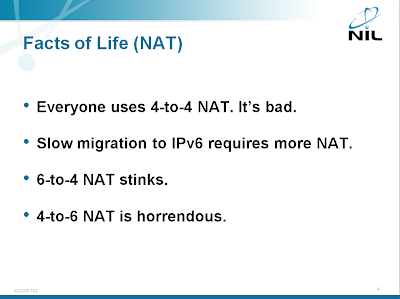NAT-PT is totally broken in late IOS releases
When the current variant of IPv6 was selected 15 years ago, seamless integration with IPv4 was a big deal, resulting in NAT-PT architecture. NAT-PT tried to solve too many problems and (as I pointed out in my IPv6 Deployment workshop), while the 6to4 NAT is manageable, the 4to6 NAT is horrific (NAT64 and DNS64 are more reasonable; more about them in an upcoming post).
NAT between IPv4 and IPv6 hosts is just one of the topics covered in the Enterprise IPv6 Deployment workshop. You can attend an online version of the workshop or we can organize a dedicated event for your team.
To make matters worse, the NAT-PT implemented in Cisco IOS is totally broken due to removal of fast switching support in IOS release 12.4(20)T and numerous other releases. As I wrote a year and a half ago, removing fast switching will bite us eventually … and so it does when you try to use NAT-PT.
NAT-PT was never working in CEF switching path; CEF switching punted packets that had to be translated to fast switching. With fast switching gone, the punted packets land in a digital black hole. To make NAT-PT work, you have to disable IPv4 and IPv6 CEF globally. Do I need to spell out how that affects the router’s performance?


I've never had any dreams about using NAT-PT. I think it is the ultimate crutch.
I made quick test in scenario with IPv6-only (ipv6ip tunnel) and IPv4-only (hardware) interfaces. With disabled IPv6 I got about 4Mbit throughput and 70% of CPU usage. Disabling IPv4 CEF had no inpact on traffic.
How much IPv6 transition will cost?
In IOS routers you can disable v4v6 dynamic NAT-PT. It is so hard for Cisco remove DNS-ALG from NAT-PT and add DNS64? Why NAT64 is supported only with IOS-XR?
How much money hardware vendors could get for selling new hardware for IPv6?
From a different point of view we could be forced to upgrade our hardware because of CPU power limitations in not IOS-XR platforms. What do you think?
Thankyou
Gianrico